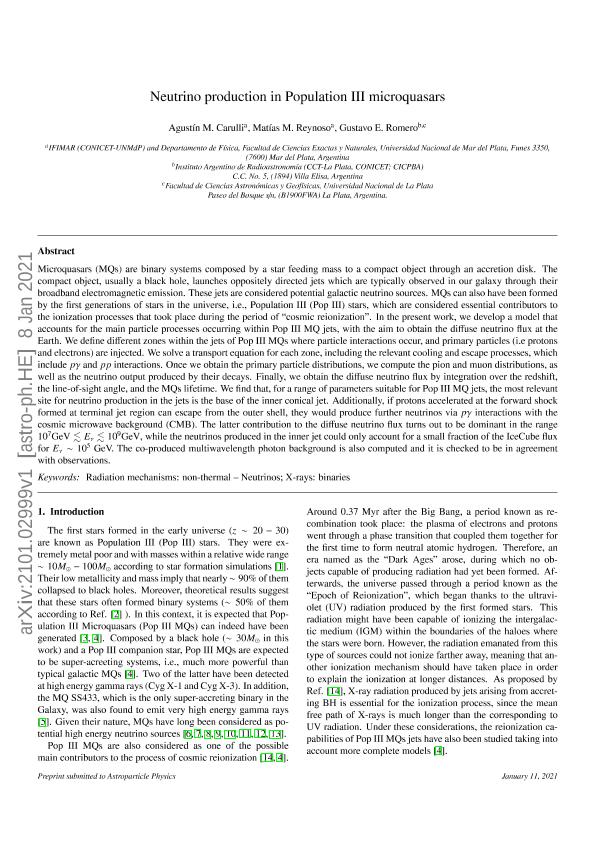Mostrar el registro sencillo del ítem
dc.contributor.author
Carulli, Agustín Matías

dc.contributor.author
Reynoso, Matias Miguel

dc.contributor.author
Romero, Gustavo Esteban

dc.date.available
2022-02-16T12:19:20Z
dc.date.issued
2021-03
dc.identifier.citation
Carulli, Agustín Matías; Reynoso, Matias Miguel; Romero, Gustavo Esteban; Neutrino production in Population III microquasars; Elsevier Science; Astroparticle Physics; 128; 3-2021; 1-20
dc.identifier.issn
0927-6505
dc.identifier.uri
http://hdl.handle.net/11336/152099
dc.description.abstract
Microquasars (MQs) are binary systems composed by a star feeding mass to a compact object through an accretion disk. The compact object, usually a black hole, launches oppositely directed jets which are typically observed in our galaxy through their broadband electromagnetic emission. These jets are considered potential galactic neutrino sources. MQs can also have been formed by the first generations of stars in the universe, i.e., Population III (Pop III) stars, which are considered essential contributors to the ionization processes that took place during the period of ãcosmic reionizationå. In the present work, we develop a model that accounts for the main particle processes occurring within Pop III MQ jets, with the aim to obtain the diffuse neutrino flux at the Earth. We define different zones within the jets of Pop III MQs where particle interactions occur, and primary particles (i.e protons and electrons) are injected. We solve a transport equation for each zone, including the relevant cooling and escape processes, which include pγ and pp interactions. Once we obtain the primary particle distributions, we compute the pion and muon distributions, as well as the neutrino output produced by their decays. Finally, we obtain the diffuse neutrino flux by integration over the redshift, the line-of-sight angle, and the MQs lifetime. We find that, for a range of parameters suitable for Pop III MQ jets, the most relevant site for neutrino production in the jets is the base of the inner conical jet. Additionally, if protons accelerated at the forward shock formed at terminal jet region can escape from the outer shell, they would produce further neutrinos via pγ interactions with the cosmic microwave background (CMB). The latter contribution to the diffuse neutrino flux turns out to be dominant in the range 107GeV≲Eν≲109GeV, while the neutrinos produced in the inner jet could only account for a small fraction of the IceCube flux for Eν∼105 GeV. The co-produced multiwavelength photon background is also computed and it is checked to be in agreement with observations.
dc.format
application/pdf
dc.language.iso
eng
dc.publisher
Elsevier Science

dc.rights
info:eu-repo/semantics/openAccess
dc.rights.uri
https://creativecommons.org/licenses/by-nc-sa/2.5/ar/
dc.subject
BINARIES
dc.subject
NON-THERMAL – NEUTRINOS
dc.subject
RADIATION MECHANISMS
dc.subject
X-RAYS
dc.subject
COVID-19
dc.subject.classification
Física de Partículas y Campos

dc.subject.classification
Ciencias Físicas

dc.subject.classification
CIENCIAS NATURALES Y EXACTAS

dc.title
Neutrino production in Population III microquasars
dc.type
info:eu-repo/semantics/article
dc.type
info:ar-repo/semantics/artículo
dc.type
info:eu-repo/semantics/publishedVersion
dc.date.updated
2022-02-15T14:21:29Z
dc.journal.volume
128
dc.journal.pagination
1-20
dc.journal.pais
Países Bajos

dc.journal.ciudad
Amsterdam
dc.description.fil
Fil: Carulli, Agustín Matías. Consejo Nacional de Investigaciones Científicas y Técnicas. Centro Científico Tecnológico Conicet - Mar del Plata. Instituto de Investigaciones Físicas de Mar del Plata. Universidad Nacional de Mar del Plata. Facultad de Ciencias Exactas y Naturales. Instituto de Investigaciones Físicas de Mar del Plata; Argentina
dc.description.fil
Fil: Reynoso, Matias Miguel. Consejo Nacional de Investigaciones Científicas y Técnicas. Centro Científico Tecnológico Conicet - Mar del Plata. Instituto de Investigaciones Físicas de Mar del Plata. Universidad Nacional de Mar del Plata. Facultad de Ciencias Exactas y Naturales. Instituto de Investigaciones Físicas de Mar del Plata; Argentina
dc.description.fil
Fil: Romero, Gustavo Esteban. Provincia de Buenos Aires. Gobernación. Comisión de Investigaciones Científicas. Instituto Argentino de Radioastronomía. Consejo Nacional de Investigaciones Científicas y Técnicas. Centro Científico Tecnológico Conicet - La Plata. Instituto Argentino de Radioastronomía; Argentina. Universidad Nacional de La Plata; Argentina
dc.journal.title
Astroparticle Physics

dc.relation.alternativeid
info:eu-repo/semantics/altIdentifier/doi/http://dx.doi.org/10.1016/j.astropartphys.2021.102557
Archivos asociados
